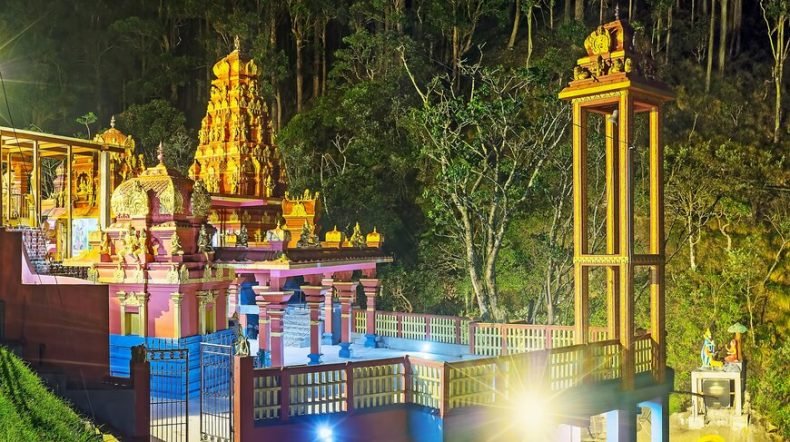
Looking for Sri Lanka Ramayana tour packages? This Sri Lanka Ramayana tour is an eight-day travel package designed to provide comprehensive details of the Ramayana trail.
The tour that begins in Chilaw is carried through various parts of the country, covering four UNESCO World Heritage Sites namely, Anuradhapura, Sigiriya, Cave Temple in Dambulla, and the Temple of the Tooth in Kandy.
The tour covers highlights of the Ramayana trail in Sri Lanka and our guides offer comprehensive details of each of the locations that are covered in the tour.
The best part of our tour package is that it doesn’t only carry Ramayana trail but also other significant religious, cultural, and historical sites in Sri Lanka.
Sri Lanka Ramayana Tour 8 Days Summary
- Day 1 – Chilaw & Anuradhapura
- Day 2 – Trincomalee
- Day 3 – Sigiriya / Dambulla
- Day 4 – Kandy
- Day 5 – Nuwara Eliya
- Day 6 – Ella
- Day 7 – Kataragama
- Day 8 – Colombo
Day 1 – Chilaw & Anuradhapura
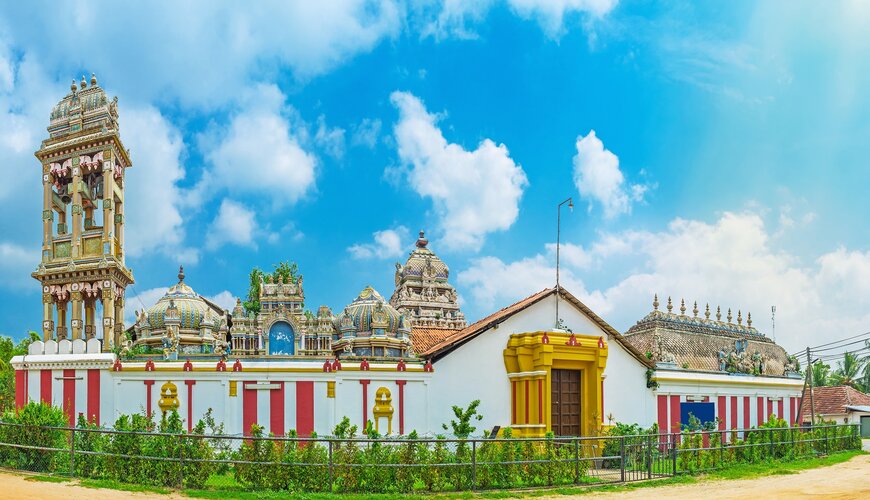
On the way to Anuradhapura on the first day of the Sri Lanka Ramayana tour, the first stop is the town of Chilaw.
Located in the Puttlam District on the North Western Province of Sri Lanka, Chilaw is significant on the Ramayana Tour due to the Manavari and Munneswaram Hindu temples.
Munneswaram Temple
Munneswaram Hindu Temple is one of the five ‘Pancha Ishwara’ Hindu temples in Sri Lanka. These five temples are dedicated to Lord Ishwara. Munneswaram temple has been in existence since 1000 CE.
‘Mun’ means long ago and ‘eswaram’ means temple of Shiva in Tamil. According to the Ramayana legend King Rama stopped at the temple for atonement from Lord Shiva after killing Ravana to free his beloved Sitha.
After killing Ravana, King Rama felt that he was followed by a dosham (curse) for murdering a person from the Brahmin caste. King Rama felt that Munneswaram temple was a safe space where he was not followed by the dosham.
As a remedy for his atonement Lord Shiva asked him to erect and pray at the four lingams at Manavari, Thiru Koneswaram, Thiruketheeswaram, and Rameshwaram so that he will be free from the dosham.
Manavari Temple
Located 9km North of Chilaw, Manavari Temple is another significant location in the Ramayana trail in Sri Lanka. According to legend, this is where King Rama installed the first Shiva lingam.
This is why it is referred to as the ‘Ramalinga Shivan’. It is the only lingam in the world to be named after Rama, apart from the one in Rameshwaram in India.
After exploring one part of the Ramayana trail, you will head to Anuradhapura. It is a significant sacred city in Sri Lanka that was also the first ancient capital in the country.
Anuradhapura is listed as a UNESCO World Heritage Site. It is the most archeologically rich city in Sri Lanka. There’s no better place in the country to discover the history and learn about the significance of Buddhism in Sri Lanka.
Many ancient kings have left a legacy of architectural and engineering marvels in this amazing historical wonder.
Anuradhapura was the foundation of Sinhala Buddhist civilization. The Jaya Sri Maha Bodhi is the highlight of Buddhism in Anuradhapura.
It is a sapling from the Jaya Sri Maha of Buddha Gaya, under which Goutham Buddha attained enlightenment.
In this part of the country, the weather is very hot and sunny. Most of the attractions are spread out therefore its best to travel by an air-conditioned car.
Since you will not have one full day, try to make the most of your time here.
The ‘must see’ sites in Anuradhapura,
– Jaya Sri Maha Bodhi
– Ruwanwelisaya
– Isurumuniya Viharaya
– Mirisawetiya Stupa
– Jethavanaramaya
– Abhayagiriya Stupa
– Kuttam Pokuna
– Samadhi Buddha Statue
After a busy day of walking and sightseeing, you can unwind at your hotel. Since most hotels in Anuradhapura are linked with nature, it will be nice and cold at night.
You can take a late night dip in the pool or enjoy a drink outdoors after dinner before calling it a night.
Suggested Read: Sri Lanka Tour Packages from Chennai
Day 2 – Trincomalee
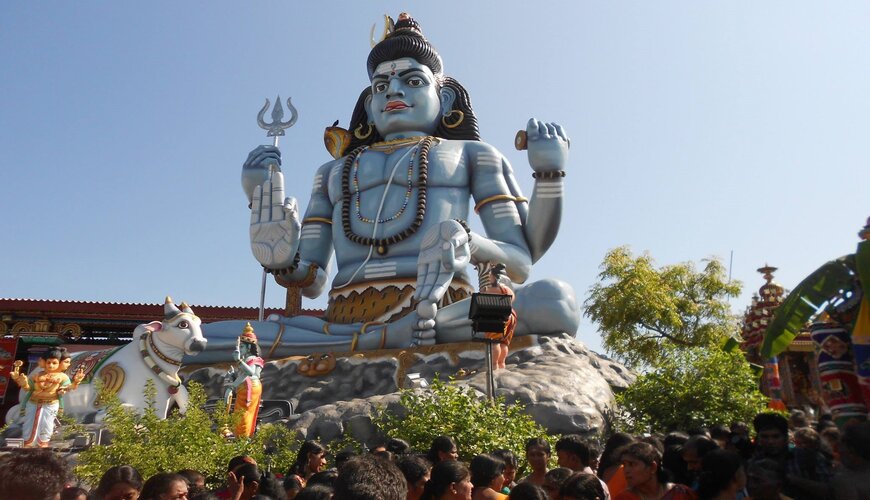
The second stop on the Sri Lanka Ramayana Tour is the city of Trincomalee. One of the most scenic beach destinations in the country Trincomalee will not fail to impress you as the home to the world’s finest natural harbour.
The town is blessed with the breathtaking beaches of Nilaveli and Uppuveli as well as the Pigeon Island national park.
The Ramayana highlight of Trincomalee is the sacred Thiru Koneswaram Temple. Perched on the stunning Swami Rock overseeing the beautiful Trinco harbour, Konneswaram Temple is dedicated to Lord Shiva.
The temple is one of the five ‘Pancha Ishwarams’ (abodes) of Lord Shiva. King Rama built the second lingam that helped him get rid of the dosham (curse) that was following him after he murdered Ravana of Brahmin cast to save his wife Sitha.
The temple is also considered significant in the Ramayana since King Ravana had come here to pray in devotion to Lord Shiva. Impressed by his devotion Lord Shiva has requested Agastya Rishi to build the temple.
The Koneswaram Temple opening hours are from 6.30am – 1pm and 4pm – 7pm. The rest of the time you can walk around the site and around the temple.
After visiting the temple you can spend time enjoying some of the following activities,
Visit Fort Frederik
The Fort Fedrick was built during the 16th century by the Portuguese and then rebuilt by the Dutch later. It is now under the Sri Lanka military but it’s open to the public.
The Fort is shaded with lots of trees and there are lots of wild deer walking everywhere.
The fort is open to visitors from 6am – 10pm but it’s best to go before 6pm when there’s daylight.
Day 3 – Sigiriya / Dambulla
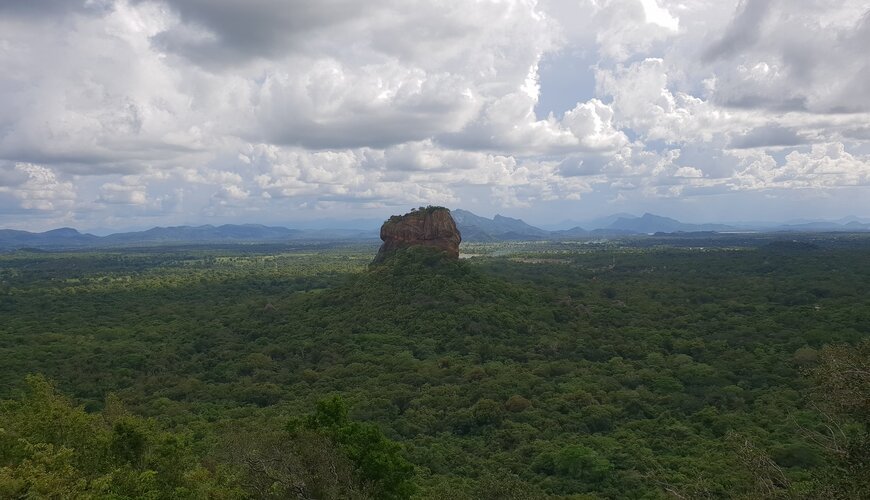
Spend an entire day and overnight stay to explore two UNESCO World Heritage Sites – Sigiriya and the Cave Temple of Dambulla.
Sigiriya
Climb the Sigiriya Rock Fortress or Lion’s Rock that rises above 200 meters among the lush green jungles. The highlight of the fortress is at the summit, which is King Kasyapa’s palace in the sky.
Locally referred to as the 8th World Wonder, it is a royal citadel for which the ruins remain as witness to its once luxurious ramparts, gateways, moats, and a well-planned city with gardens and bathing pools.
On the way up you will pass the Mirror Wall, which was once so polished, that the king could look at himself on it. The ancient frescos of the Sigiriya damsels are another must-see.
Exploring the Rock
To thoroughly explore Sigiriya Rock, it will take at least 2-3 hours. The best time to visit is early morning or late afternoon when it’s less sunny. Try to avoid the weekends especially Sundays and Poya holidays since it gets congested.
The stairway is pretty narrow and the crowds become too much to handle sometimes. The climb up is not as exhausting as it looks from the bottom but if you are scared of heights then it might get a bit unpleasant in certain sections.
Attractions of Sigiriya Museum
Sigiriya Museum is located next to the ticket counter near Sigiriya Rock. The ticket to the fortress covers a tour of the museum but many who choose to climb first, end up not going to the museum since they are tired after the climb.
Our advice is to go to the museum before the climb. There are six galleries displaying artifacts and details of different eras. Each of the six galleries displays information to learn about Sri Lankan history and culture.
Dambulla Cave Temple
After climbing the Sigiriya, it’s best to go to Dambulla in the evening. The Dambulla Cave Temple is an ancient temple that consists of five well-preserved caves.
The caves were established as a monastery during the 3rd Century BC. To access the temple you need to ascend a gentle slope and once you reach the top, enjoy the panoramic views.
There are hundred and fifty Buddha statues in the temple and the walls are covered with ancient murals that date back to 2000 years.
The murals depict historical stories of Buddhism and Sinhala Buddhist culture in Sri Lanka.
Day 4 – Kandy
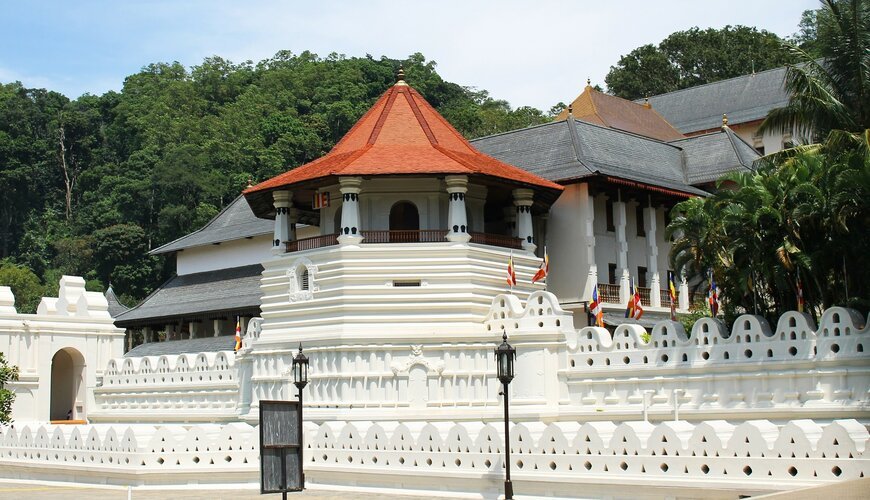
Kandy is the hill capital and the holiest city in Sri Lanka. It is a significant site in the central highlands due to the most venerated Buddhist temple Dalada Maligawa or Temple of the Tooth.
Kandy was the final Sinhala Kingdom before the Portuguese invaded the city.
Kandy holds a rich history and many hailing from the city are proud of their roots and even consider themselves a tad bit above the rest of the people in the country.
The Dalada Maligawa houses the sacred tooth relic of Buddha. The temple hosts the annual procession Esala Perahera, which is one of the foremost Buddhist festivals in Asia.
The procession also includes the participation of the Hindu community from the Hindu temples and shrines and the temple.
There is a two-week celebration leading to the processions and it begins with an opening ceremony at the Vishnu temple.
During the procession chariots from the four Hindu Devales (temples) follows the casket carrying the tooth relic, which is usually kept on the back of a tusker elephant.
The Esala Perahera is generally hosted at the end of July or mid-August.
Apart from the Dalada Maligawa, you can also visit the Embekke Devalaya, Lankathilaka Viharaya, and Gadaladeniya Viharaya.
The close connection between the Sinhala Buddhists and Hindus are clear from the presence of a Devale (Hindu shrine) at every Buddhist temple.
At the Lankathilake Viharaya (Buddhist temple), there are five Devales (Hindu shrines) dedicated to the deities Upulvan, Ganapathi, Saman, Vibhishana and Kumara Bandara.
Make sure you go for a Kandyan dancing performance during your time in the city.
Kandyan dancing is the national dance style of Sri Lanka. The dancers wear a striking costume and the dance acts depict various animal movements and portray scenes and stories related to kings, heroes and the Ramayana.
The Kandyan dance acts are amazing to watch but learning the dance style takes years of training and determination.
Day 5 – Nuwara Eliya (Sri Bhaktha Hanuman Temple, Sita Amman Temple, Ashok Vatika)
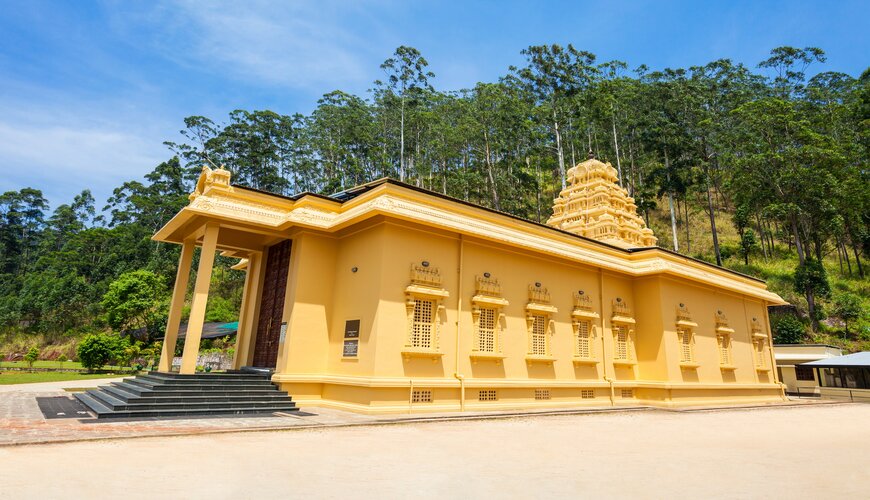
On day five of the Sri Lanka Ramayana tour, you will go to the mountainous city of Nuwara Eliya.
The central highland where King Ravana held Sita captive is home to several temples built on behalf of King Rama, King Ravana, and Lord Hanuman.
The Sita Amman Temple, Sri Bhaktha Hanuman Temple, Divurumpola Temple, Ashok Vatika, and Divurumpola are some of the main ones.
Sri Bhaktha Hanuman Temple
The Chinmaya Mission of Sri Lanka built Sri Bhaktha Hanuman Temple. The exact location is now called Ramboda and it is around 40km from Nuwara Eliya. Lord Hanuman is the leading deity of the temple.
Built on a stunning location overlooking the Kotmale valley, Sri Bhaktha Hanuman Temple is a prominent site on the Ramayana trail.
As per the Ramayana legend, Lord Hanuman has searched for Sita in the forest behind the temple. There had been an empty trail called the ‘chariot path’ on which King Ravana took Sita to show his kingdom and the Ashoka Vatika where she was held captive.
There is a statue of Lord Hanuman that stands at a height of 40 feet in the temple. According to legend Lord Hanuman has searched for Sita from the hills of Ramboda.
It is believed that King Rama gathered his forces against Ravana from this area.
Special poojas (prayers and offerings) are conducted at the temple on full moon days. Flower garlands are used to decorate the temple and the statue of Hanuman.
Sita Amman Temple
Sita Amman Temple in Nuwara Eliya is the only Hindu temple dedicated to Queen Sita in Sri Lanka. This is located within a 10-minute drive from the Nuwara Eliya town, it is an important site in the Ramayana trail.
The soil at the temple is black and according to the Ramayana it is believed that Lord Hanuman burnt this area before he left, so this is considered the reason for the colour of the soil.
According to the Ramayana there is proof this is the location Queen Sita was kept in captive.
There is a stream that runs beside the temple and it is believed that Sita bathed from it.
The temple is open every day of the week. The pooja times are from 8am – 1pm and 2pm – 6.30pm.
Ashoka Vatika
Ashoka Vatika is believed to be a beautiful garden where Ravana kept Sita captive in Lanka. Exact demarcation of the land is unclear but it is believed that the Hakgala Botanic Garden is built on the same premises.
This is the area surrounding the Sita Amman Temple and the stream on which you can see Lord Hanuman’s footprints even today.
According to the Ramayana story Sita preferred to stay in the Ashok Vatik instead of Ravana’s palace.
It is said that the Ashoka tree in the garden has provided shelter and comfort to the distressed Queen Sita.
Day 6 – Ella
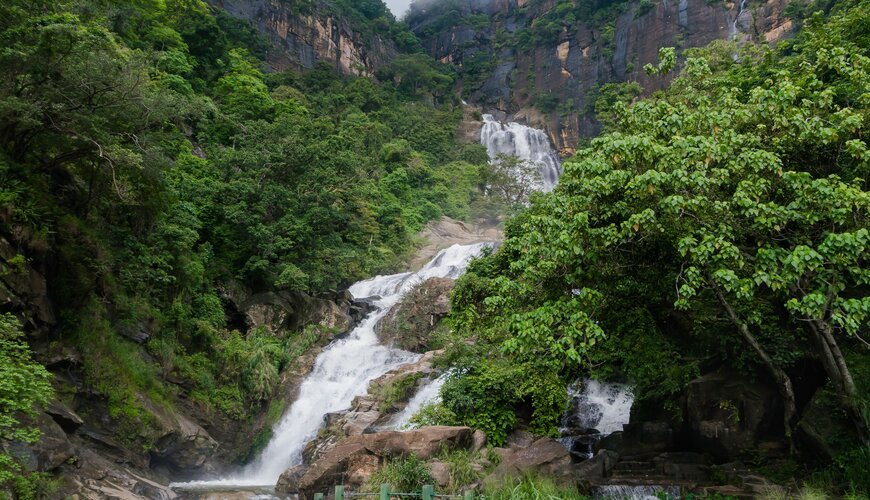
Ella is a small village nestled within a short drive from the Nuwara Eliya town. As the name suggests Ravana Cave and Ravana Ella have significance to the Ramayana trail in Sri Lanka.
Ravana Cave
The Ravana cave and connecting tunnel network during King Ravana’s reign are considered an architectural brilliance.
The network of tunnels through the caves creates a secret passage that leads to major cities, airports, and farms. These tunnels are proven to be manmade and no natural formations.
According to the Ramayana legend King Ravana who learned of King Rama and his army approaching the island, hid Sita inside these caves behind the waterfall, hoping to keep them from rescuing her.
Similar tunnel openings are also situated at,
-Ishtripura in Welimada
-Senapitiya in Halagala
-Ramboda
-Labookelle
-Wariyapola in Matale
-Seetha Kotuwa in Hasalaka
The above is evidence that even though Ravana was a ruthless ruler, he was also has a brilliant mind. If he had focused more on the wellbeing of his kingdom rather than his personal interests, he would have made a substantial contribution to Sri Lanka.
Visiting the Cave
The Ravana Cave is located within 2km from the Ella town. To reach the cave you need to first come to the Maha Ravana Viharya and a short hike of around 500 meters will take you to the cave.
Since the climb is quite difficult with more than 600 unevenly steep steps, the cave may not seem that impressive.
It is quite small and measures up to 60ft high, 50ft wide, and 150ft long. But don’t forget it’s historical importance and how it connects to the Ramayana trail.
During archeological excavations, a human skull dating back to 20,000 BC was discovered from the cave.
Ravana Falls
There are two waterfalls in Ella that are called the Ravana Falls. The most popular is the one on the Bandarawela – Wellawaya road.
This is a quite popular tourist spot where people stop over to admire the cascading flow of water and enjoy the atmosphere.
The second waterfall is above this and is no visible to the main road. This is considered the ‘real’ Ravana falls since its located very close to the Ravana cave.
The actual name of the waterfall visible to the main road is said to be Bambaragama Ella.
You can explore both waterfalls and listen to the interesting stories related to them.
After completing the Ramayana trail in Ella, you can also do a hike to the little Adam’s Peak, which is one of the popular tourist attractions in the area.
Out of all the locations you visited during the past couple of days, you will notice that Ella has the best backpacker vibe.
Things get pretty happening after sundown so head to the town to enjoy dinner and drinks at the outdoor bars and restaurants serving some fantastic western dishes.
You also find Sri Lankan and Indian restaurants if you are looking for something close to home.
Day 7 – Kataragama
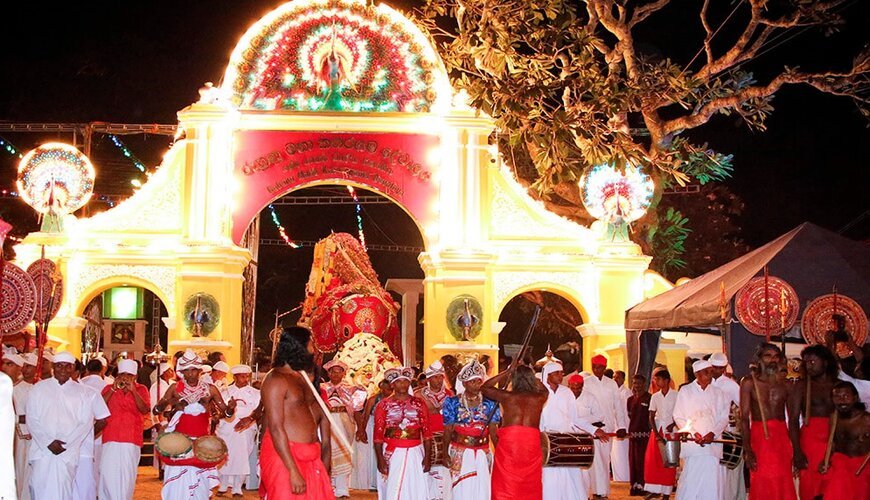
On the 7th day of the Sri Lanka Ramayana Tour, we will take you to Kataragama. After spending two days in the Central Highlands, the first thing you will notice once you get here is the shift in weather.
The weather in Kataragama is scorching hot and far from the cool climate in Ella and Nuwara Eliya.
Kataragama Devalaya (Temple) is rich in history and it stands on a hallowed ground treaded by Gautama Buddha during his visit to the island. This is a site that is revered by Buddhists, Hindus, and the Vedda community of Sri Lanka.
The temple is dedicated to Kataragama Deviyo (deity) who is also called Skanda Kumara or Kartikeya. There is a large Bo Tree in the temple, which is a sapling from the Sri Maha Bodhi in Anuradhapura.
To reach the temple, you need to take a short walk so make sure to avoid going in the afternoon since walking barefoot when the ground is hot is not fun! The Kataragama temple has three poojas during the day.
You can offer a fruit basket with some money and half of the fruits will be returned for you to consume.
It is mentioned in Ramayana that Lord Karthikeya was requested to go to the battlefield during the fight between King Ravana and King Rama, since he can protect Rama from the wrath of Brahmasthra aimed by Ravana.
His presence helped protect Rama when Ravana used one of the most powerful weapons, Brahma Asthma during battle.
You can also visit the Kiri Wehera Buddhist temple that can be reached on foot from the Kataragama temple.
Ussangoda Ramayana site
A short drive from Kataragama takes you to Ussangoda. According to the Ramayana, King Ravana used the flat land in Ussangoda to park his pushpak vimana, which is something similar to an aeroplane.
It is also believed that Hanuman burnt the ground here, which made the soil blackish colour, and the land was made barren.
Day 8 – Colombo
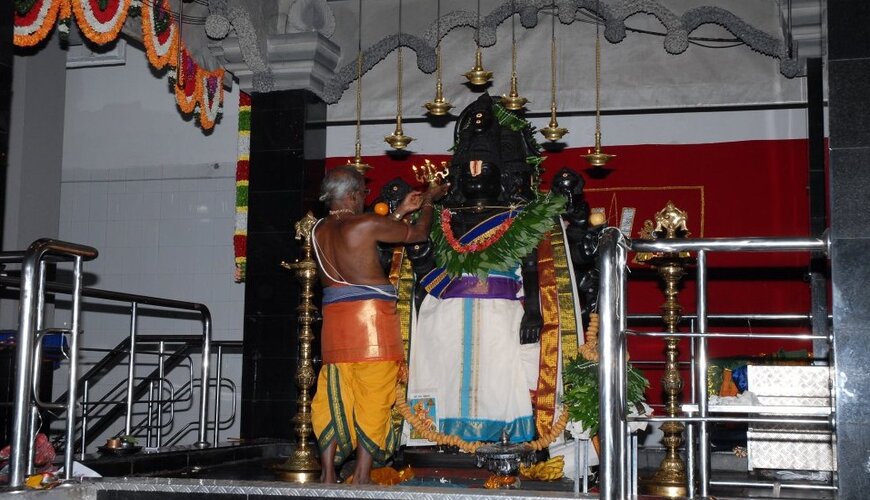
On the last day of the Sri Lanka Ramayana tour, we take you to the biggest city in the country – Colombo!
Panchamuga Anjaneyar Temple
Panchamuga Anjaneyar Temple is the first Anjaneyar Temple in Sri Lanka. Panchamuga translates to five faced and Anjaneyar translates to hanuman in Tamil.
This is the only temple dedicated to Lord Hanuman in his Panchamuga form in the country. It is the only temple in the world to have a chariot festival for deity Anjeneyar every year from December to January.
Sri Ponnambalawaneswaram Temple
Ponnambalam Mudaliyar built the Sri Ponnambalawaneswaram Temple when Sri Lanka was under British rule. He intended to build a place of worship for the Hindus living in the area.
It was a small temple dedicated to god Shiva when it was built. But when his son Sir Ponnambalam Ramanathan inherited it in 1905, he transformed it into the temple we see today.
Sir Ponnambalam Ramanathan is a freedom fighter that was at the forefront to gain Independence to the country when the nation was under British rule.
The temple is made of solid granite and is one of the few that is found in the country. Since it is made of stone, the inside is quite dark and only the light of the oil lamps makes it bright.
The inside of the temple is intricately designed with walls, arches, and pillars decorated similar to Mayan temples. The ceiling is adorned with sculptures of swans, peacocks, cows, gods, and goddesses of Hinduism.
The Sri Ponnambalawaneswaram Temple is designed similar to Indian temples and the work of art is not seen elsewhere in Sri Lanka. There is a lot of time and effort gone into creating each pillar, wall, and sculpture.
Kelaniya Raja Maha Viharaya
The Kelaniya Buddhist Temple is located within a short drive from the city of Colombo. Built overlooking the Kelaniya River, it is one of the most sacred sites in Sri Lanka.
It is believed that Buddha along with 500 Arahats visited the temple on a Vesak day (full moon). Kalaniya Viharaya has a long history and the architecture, murals, and designs of the temple are amazing.
The Duruthu Perahera (Kelani Procession) starts from the Kelaniya Temple. Inaugurated in 1927, it is a grand procession that is held on the day before the full moon day of January, annually.
For a Sri Lanka Ramayana tours that is safe, enjoyable, and hassle-free try the tour package from T2 Travels Sri Lanka.
We offer customized Sri Lanka Ramayana tour packages and all our tours are ‘tried and tested’ to offer visitors a smooth and enjoyable experience.
